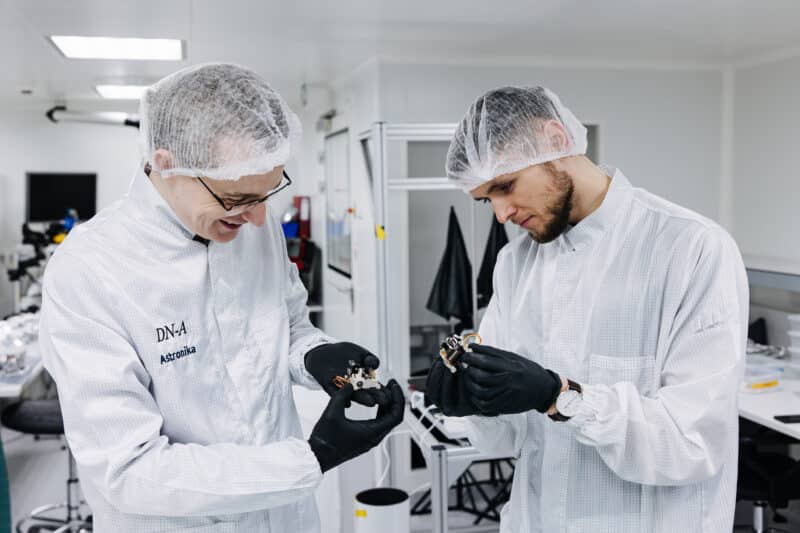Yesterday at the European Space Agency’s Center for Space Research and Technology (ESA-ESTEC), Polish engineers from the company Astronika presented the completed mechanism of the lunar jumper’s leg. Commissioned by the ESA, the Polish team is working on an alternative to rovers, as these are not always able to cope with difficult terrain and unpredictable conditions. The jumper, by its nature, will have no problems in mountainous regions, which hide a wealth of interesting information for scientists about other celestial bodies.
In the recently concluded and successful first phase of the project, the jumper’s legs were designed, made and tested. As can be easily guessed, their mechanism is key to the operation of the entire robot. After a successful presentation, the engineers from Astronika are counting on the continuation of the project and the commissioning by ESA of the construction of a full model, ultimately intended for lunar and planetary missions. Even at this stage, it can be said that this is very likely, especially since there are many missions to the Moon and asteroids planned for this decade.
Polish Specialization?
The technology developed by the Polish team is now highly sought after, as it solves many problems encountered by previous missions landing on celestial bodies (eg toppled landers, landings in more difficult than expected terrain). Notably, the jumping robots tested so far by other manufacturers, due to the low energy of the jump, could only effectively move in microgravity and the same technology could not be applied on the Moon or Mars. Others are based on multi-link walking structures, but this requires the use of a lot of energy in a short time, which shortens the operational time and limits the exploration of larger areas. Astronika’s Jumper is very light (less than 10kg) and energy efficient and is to achieve jumps on the moon up to a height of over 3 meters.
“Our solution uses the concept of pushing off the surface using light legs like a grasshopper. Once designed for lunar gravity, it is easily scalable to smaller gravities. Our design is based on simplicity and resilience, with very low power consumption,” says Łukasz Wiśniewski, project manager.
Our engineers are therefore pioneers in the development of this innovative technology – they may make a breakthrough in the way celestial bodies are explored. This is good news for the entire Polish space sector, as designing and building from scratch jumping robots dedicated to various missions will require the cooperation of many entities, and hence, we will have the opportunity to build unique know-how and our national specialization.
The work on the jumper technology was financed by the European Space Agency as part of the PLIIS (Polish Industry Incentive Scheme) program in cooperation with the Space Research Center of the Polish Academy of Sciences and was made possible thanks to good coordination between the Polish space sector and the Ministry of Development and Technology and the Polish Space Agency.
What will such a robot be capable of?
During a lunar mission, the jumper will perform tasks such as: characterization of lunar dust, spectrometric measurements, testing of hydrazine concentrations, photographing the mother lander from different perspectives, and surface bearing analysis. With the use of its unique ability to jump and a set of cameras, the robot will also investigate the mechanical properties and morphology of the regolith. All these activities will increase our knowledge about the impact of regolith on planetary mobility, and as a result, with the help of a small resource like the Jumper, will improve the safety, planning, and reduce the cost of future space missions.
What will it look like?
The final configuration will be confirmed in the next stage of the platform’s development, but one of the assumptions is to combine the function of wheels with the function of jumping legs: the wheel will be placed on the leg, which, if necessary, will enable high jump using an already developed actuator.
To find out how a jumping robot will change the way planets are explored, we ask the project manager Łukasz Wiśniewski:
“Until now, most exploratory missions have been planned very conservatively. Rovers and landers were sent only to relatively flat, safe terrain, which unfortunately provides scientific information only about the freshest history of the celestial body (and yet often these machines landed in unexpectedly difficult conditions or tipped over and slowly became useless!). Much more interesting is to deliver scientific instruments to hard-to-reach areas, such as cliffs, rocks and canyons, where you can see a cross-section of the history of the celestial body. However, no one would dare send a rover worth several hundred million euros on a potentially suicidal mission. A small jumping robot is relatively inexpensive for a mission and easy to bring aboard. It’s like a clever and helpful scout who can do a reconnaissance in risky terrain before a rover enters. Not only does it increase the safety of the entire mission, but it also maximizes its scientific return. Additionally, it provides valuable information about the mechanical properties of the surface, which helps increase the accuracy of motion planning. If the Jumper gets stuck somewhere, it doesn’t matter! That’s exactly its task, to get where no one has tried before and perform pioneering measurements. At the same time, the mission does not lose the ability to perform its main objectives through the mother lander or mother rover he explains.
